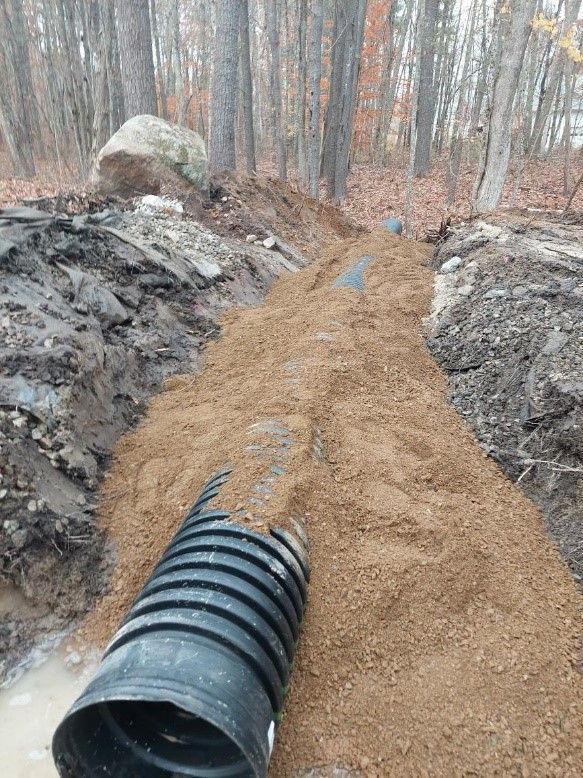Safe and Efficient Tree Removal Services
Wiki Article
Culvert Setup Facilitated: Step-by-Step Guide for Success
Mounting culverts might seem like a straightforward task, yet making certain a successful outcome requires careful planning and implementation. From picking the appropriate culvert dimension to incorporating proper drain procedures, each step in the installation procedure plays a critical function in the capability and durability of the culvert system. By complying with a methodical strategy and paying interest to crucial details, the installation can continue efficiently, minimizing prospective problems down the line. Stay tuned to uncover the crucial steps and considerations that can make culvert setup a seamless and effective endeavor.Selecting the Right Culvert Dimension
Choosing the suitable culvert size is crucial for guaranteeing efficient water circulation and structural integrity in culvert installation projects - Pad Construction. The dimension of the culvert straight impacts the circulation capacity of water with the framework. A culvert that is as well small can result in flooding and overflow, while one that is as well huge may result in decreased water rate, potentially causing debris buildup and clogsTo figure out the ideal culvert dimension, aspects such as the watershed location, height circulation rates, and hydraulic efficiency demand to be thoroughly thought about. Calculations based on these parameters assist in selecting a size that can adequately deal with the expected water volume while reducing the threat of clogs and architectural failing.
It is crucial to seek advice from design standards and standards to guarantee that the selected culvert size satisfies the job requirements and regional guidelines (Pad Construction). By selecting the appropriate culvert dimension, job supervisors can optimize water flow, stop possible issues, and enhance the total efficiency and longevity of the culvert installment
Preparing the Setup Website
Reliable culvert setup demands precise preparation of the installment site to make certain optimal structural assistance and capability. Prior to beginning the setup process, it is critical to get rid of the site of any type of debris, plants, or blockages that can hamper the culvert's positioning. Guaranteeing a level foundation is vital for the proper placement and security of the culvert. This may entail rating the website to create a smooth, even surface that can adequately sustain the weight of the culvert and any awaited loads. Furthermore, proper compaction of the dirt below the culvert is necessary to stop clearing up or shifting over time.Moreover, it is necessary to think about elements such as dirt composition, groundwater levels, and ecological Tree removal effects when preparing the setup site. Conducting an extensive website assessment can aid determine any type of possible challenges or risks that might influence the culvert's performance. By making the effort to prepare the installment website correctly, you can help ensure an effective culvert installment that satisfies structural requirements and makes sure long-term performance.
Placing the Culvert Properly

The quality at which the culvert is placed is crucial for maintaining an appropriate incline for water circulation. A steady incline helps protect against merging and promotes effective drainage. In addition, the culvert should be oriented appropriately to make certain that the inlet and outlet remain in the correct places. This orientation is crucial for the culvert to operate properly in taking care of water circulation.
Backfilling and Compacting the Soil
Correct backfilling and compaction of the dirt around the culvert is necessary to make certain security and avoid possible concerns in the future. When the culvert is correctly put, the next vital action is to backfill the area around it with ideal material. The backfill material must be devoid of rocks, debris, and organic matter to stay clear of damages to the culvert. It is recommended to use granular product such as sand or gravel for backfilling, as it gives good water drainage and compaction residential properties.Compaction aids in minimizing the chances of settlement and guarantees uniform assistance around the culvert. It is crucial to portable the dirt equally on all sides of the culvert to keep its architectural stability.
Proper backfilling and compaction not only provide stability to the culvert yet also help in preventing dirt disintegration and preserving the long life of the culvert system.
Ensuring Appropriate Drainage Assimilation
Incorporating reliable water drainage solutions plays an important role in the total capability and durability of culvert installments. Correct drainage integration is important for handling water circulation, preventing erosion, and ensuring the architectural honesty of the culvert system. To accomplish this, it is vital to create a comprehensive drain plan that considers elements such as the volume of water expected, the topography of the area, and the sort of dirt existing.
Furthermore, including features like erosion control steps, such as riprap or greenery, can better improve the efficiency of the drainage system. By meticulously preparing and carrying out these drainage services, culvert installments can function efficiently and endure the examination of time.
Conclusion
Finally, correct culvert installation is vital for keeping reliable drainage systems. By selecting the appropriate culvert dimension, preparing the setup website, placing the culvert correctly, backfilling and compacting the soil, and ensuring proper water drainage assimilation, success can be accomplished. Following these steps will certainly aid make sure the durability and efficiency of the culvert, eventually adding to the general success of the drainage system.Report this wiki page